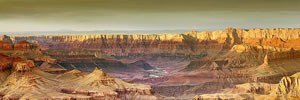The Grand Canyon is the largest gorge on Earth, extending for 444km (277mi) along the Colorado River.
The Grand Canyon's walls were created almost entirely by the action of the river's waters.
At its deepest point, known as Granite Gorge, the canyon drops away for 1.6km (1mi). At its widest, the canyon spans 29km (18mi).
 Precipitous walls and rugged spines of rock split the landscape into a complex labyrinth of canyons.
Precipitous walls and rugged spines of rock split the landscape into a complex labyrinth of canyons.
History of the Grand Canyon
The river has eroded layer upon layer of rock. As the canyon has grown deeper, the earliest part of Earth's history has been revealed.
The schist rocks at the bottom of Granite Gorge are 2 billion years old. They were formed when the molten core of the Earth punctured its surface.
The uppermost layers of the canyon date from the Paleozoic Era, which began around 600 million years ago.
Composed of various sandstones, shales and limestones, these layers were laid down as sediment at the bottom of an ocean. The most recent layer is 250 million years old.
Around 10 million years ago, the ocean dried up and was a flat plain replaced it. A river, now known as the Colorado, wound around this plain.
Upheavals in the Earth's crust caused the rocks of northern Arizona and southern Utah to push upward in a large dome.
The Colorado narrowed around two million years ago, becoming more increasing in power. The river wore away the valley's base as fast as the surrounding rocks bulged upward.
Because of this, as the surrounding rock walls grew higher and higher, the course of the river was basically unchanged.